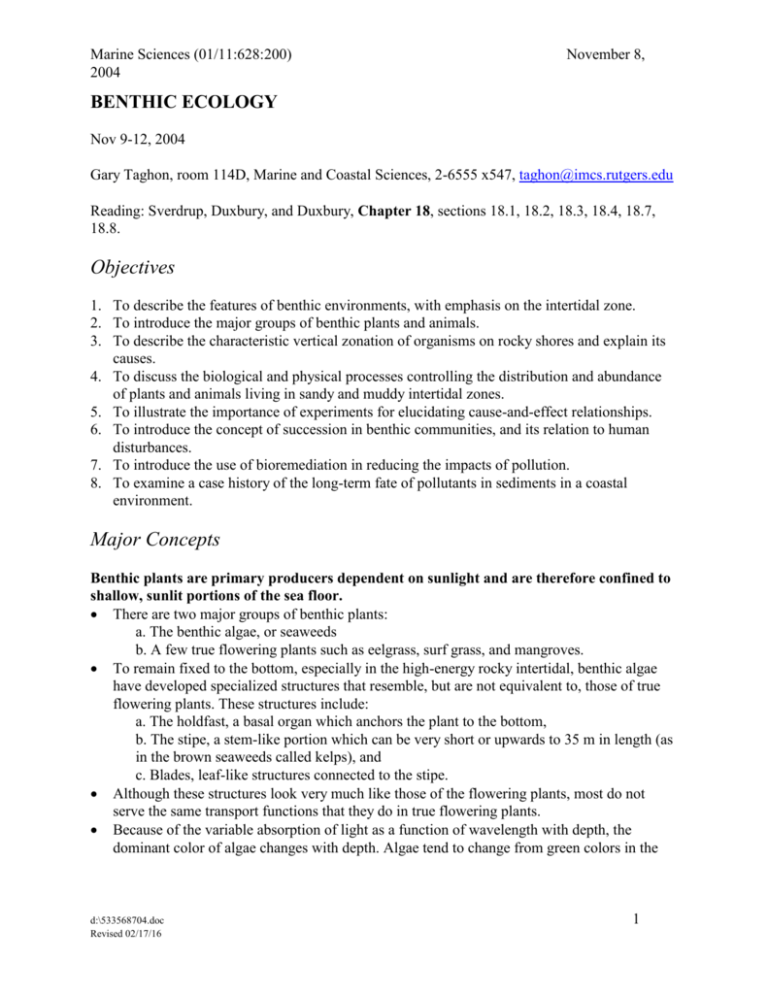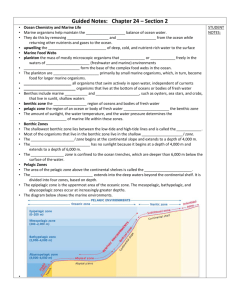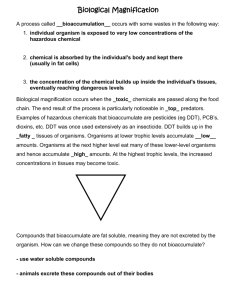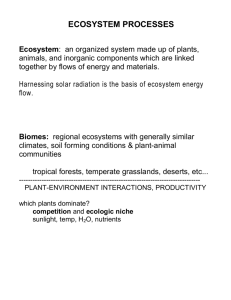BENTHIC ECOLOGY - Institute of Marine and Coastal Sciences
advertisement

Marine Sciences (01/11:628:200) 2004 November 8, BENTHIC ECOLOGY Nov 9-12, 2004 Gary Taghon, room 114D, Marine and Coastal Sciences, 2-6555 x547, taghon@imcs.rutgers.edu Reading: Sverdrup, Duxbury, and Duxbury, Chapter 18, sections 18.1, 18.2, 18.3, 18.4, 18.7, 18.8. Objectives 1. To describe the features of benthic environments, with emphasis on the intertidal zone. 2. To introduce the major groups of benthic plants and animals. 3. To describe the characteristic vertical zonation of organisms on rocky shores and explain its causes. 4. To discuss the biological and physical processes controlling the distribution and abundance of plants and animals living in sandy and muddy intertidal zones. 5. To illustrate the importance of experiments for elucidating cause-and-effect relationships. 6. To introduce the concept of succession in benthic communities, and its relation to human disturbances. 7. To introduce the use of bioremediation in reducing the impacts of pollution. 8. To examine a case history of the long-term fate of pollutants in sediments in a coastal environment. Major Concepts Benthic plants are primary producers dependent on sunlight and are therefore confined to shallow, sunlit portions of the sea floor. There are two major groups of benthic plants: a. The benthic algae, or seaweeds b. A few true flowering plants such as eelgrass, surf grass, and mangroves. To remain fixed to the bottom, especially in the high-energy rocky intertidal, benthic algae have developed specialized structures that resemble, but are not equivalent to, those of true flowering plants. These structures include: a. The holdfast, a basal organ which anchors the plant to the bottom, b. The stipe, a stem-like portion which can be very short or upwards to 35 m in length (as in the brown seaweeds called kelps), and c. Blades, leaf-like structures connected to the stipe. Although these structures look very much like those of the flowering plants, most do not serve the same transport functions that they do in true flowering plants. Because of the variable absorption of light as a function of wavelength with depth, the dominant color of algae changes with depth. Algae tend to change from green colors in the d:\533568704.doc Revised 02/17/16 1 Marine Sciences (01/11:628:200) 2004 November 8, uppermost part of rocky shore areas to brown at mid-intertidal depths and finally to red at greater depths. Intertidal environments are subject to rapid and drastic environmental changes. The distribution of the organisms that live there is governed by their ability to deal with the stresses brought on by periodic exposure, the high energy of wave and tidal turbulence, and interactions (such as competition and predation) with other organisms. Even with the harsh nature of this environment it can be as, or more, productive than tropical rain forests. Organisms in rocky intertidal areas are arranged in a “vertical zonation.” These zones include: a. The ‘splash’ zone: organisms in this zone are adapted for long periods of exposure to air and the possibility of desiccation. b. The upper intertidal: organisms here are exposed to desiccation as well as the force of breaking waves. c. The mid-intertidal: in this zone, periods of exposure to air and the threat of desiccation are reduced, but living in prime real estate has its price as competition for space and predation becomes increasingly important. d. The lower intertidal: this area is not subject to severe wave or tidal forces except for minus tides, therefore more delicate sessile species and motile species not adapted for high energy live here. The zonation of organisms is narrow where the beach is steep or the tidal range is small, and wide where the beach is flat or the tidal range is large. The animals that live in or on soft bottoms or unconsolidated sediments such as sand or mud face very different living conditions than those living on rocky shores. High-energy beach areas are unstable, and lack the amount of plant and animal life seen in the rocky intertidal. Low-energy, depositional environments are much more favorable for more diverse and more abundant faunal assemblages. Sand is porous and permeable, and oxygen-rich water penetrates deeply into sandy sediments. Silts, muds, and clay-rich sediments, due to lower permeability, will only be oxidized a few millimeters to centimeters into the bottom. Many organisms circumvent this problem by vigorously pumping overlying water through their burrows or by extending siphons above the sediment surface. Most animals living in muddy sediments are deposit feeders, ingesting small bits of organic debris on or in between sediment grains. Bacteria living in sediments are also an important source of food, in addition to their role in decomposing dead organic matter. Succession refers to the pattern in which plants and animals colonize a newly available habitat or re-colonize a habitat after a severe disturbance eliminated most organisms. Knowledge of how succession proceeds is essential for determining the recovery of habitats disturbed by both natural and human causes. d:\533568704.doc Revised 02/17/16 2 Marine Sciences (01/11:628:200) 2004 November 8, In some habitats succession is highly predictable and culminates in the establishment of a “climax” community. In other habitats succession is less predictable. Bioremediation is using organisms as biological tools to remove or degrade pollutants. There are two main approaches to bioremediation. In one, the emphasis is on accelerating the activities of organisms (primarily bacteria) already present in the environment. The second approach is to inoculate the polluted environment with non-indigenous organisms that are metabolically capable of degrading the pollutants. Our understanding of the long-term fate of pollutants in the marine environment is rudimentary. Many pollutants accumulate in bottom sediments and become buried, but because of the bioturbation activity of benthic animals the pollutants may resurface at a later date. The history of DDT discharge into the ocean off southern California and the subsequent questions regarding the fate of the DDT illustrate many of our uncertainties. d:\533568704.doc Revised 02/17/16 3 Marine Sciences (01/11:628:200) 2004 d:\533568704.doc Revised 02/17/16 November 8, 4 Marine Sciences (01/11:628:200) 2004 d:\533568704.doc Revised 02/17/16 November 8, 5 Marine Sciences (01/11:628:200) 2004 November 8, Succession: changes over time in the species composition of a community (often in response to a disturbance) Three models of succession Time 0 Time 1 Time 2 Time 3 Model Disturbance opens space; slate wiped clean Only certain species No special requirements for first can establish colonizers themselves in open space; "Opportunists," "Fugitives", "Weeds" First colonists modify First colonists make First colonists environment so it environment less make environment becomes less suitable suitable for their less suitable for all for their further own further subsequent species recruitment but more recruitment, but suitable for other these modifications species have little or no effect on other species Process continues Process continues First colonists until residents no until no species can continue to hold longer facilitate invade and grow in space and exclude recruitment of other presence of all others (First species residents (No Come, First Vacancy sign goes Served) out) FACILITATION TOLERANCE INHIBITION Modified from Connell, J.H. and R.O. Slatyer. 1977. Mechanisms of succession in natural communities and their role in community stability and organization. The American Naturalist 111: 1119-1144. d:\533568704.doc Revised 02/17/16 6 Marine Sciences (01/11:628:200) 2004 d:\533568704.doc Revised 02/17/16 November 8, 7 Marine Sciences (01/11:628:200) 2004 1874 1939 1947 1962 1972 1982 1987 June, 1990 19921994 March, 1995 August, 1995 November 8, DDT (dichloro-diphenyl-trichloroethane) is first synthesized Paul Müller, a Swiss scientist, discovers that DDT is a potent insecticide. He wins a Nobel Prize. Montrose Chemical Corp., located in Torrance, CA, begins manufacturing DDT. Over the next 25 years, Montrose becomes the largest manufacturer of DDT in the world. DDT becomes the most widely used pesticide in history. The Los Angeles Country Sanitation Districts (LACSD) issues Montrose a permit to discharge waste through the county sewer system. Silent Spring, written by Rachel Carson, is published. Use of DDT is banned in the United States, although other countries continue to permit its use. Montrose shuts down. The US Environmental Protection Agency requires the LACSD to go to full 2 treatment of wastewater, as required by provisions of the Clean Water Act. LACSD applies for waiver, arguing this action would lead to environmental risk. The US Justice Department sues Montrose and LACSD for environmental destruction, for violation of federal law that requires preservation of “balanced, indigenous populations” of wildlife. Surveys by the US Geological Survey show extensive area of sediment contains DDT US District Judge A. Andrew Hauk of Los Angeles, who had been presiding over the suit since it was filed, dismisses government lawsuit, ruling that the case was barred by statute of limitations. He also rules that the cap on damages is $50 million US Army Corps of Engineers proposes placing a 6-ft thick cap of sand over contaminated sediments. Estimated costs: $235-403 million initially, $4 million every year for maintenance. Other possible actions: 1. Dredge and haul to diked-off area on shore, cover with clean fill. Cost: $608-1,040 million 2. Dredge and incinerate on shore. Cost: $2,000-7,000 million Any option still makes this the second-most expensive cleanup for a single site. d:\533568704.doc Revised 02/17/16 8 Marine Sciences (01/11:628:200) 2004 July, 1996 January, 1997 August, 2000 October 2, 2000 October 27, 2000 d:\533568704.doc Revised 02/17/16 November 8, EPA declares the ocean floor off southern California a Superfund site, citing continued harm from DDT to bald eagles, peregrine falcons, fish, dolphins, and other marine life. Fishing bans are instituted. US 9th Circuit Court of Appeals unanimously reverses Hauk’s decision, ruling that he misinterpreted the statute. Appellate judges also reverse the cap on damages. Lawsuit reinstated. US Justice Department and California Attorney General’s Office seek $150 million for damages to natural resources. EPA begins small-scale capping of 135 acres of bottom. Plan to monitor for “several years.” US District Judge Manuel Real rules that DDT in sediment is responsible for long-term injuries to bald eagles and peregrine falcons on California’s Channel Islands. Montrose settles out of court, for undisclosed amount, for damages to natural resources. Issue of who must pay for clean up of contaminated sediments – Montrose or federal Superfund – remains before a federal appeals court. 9







